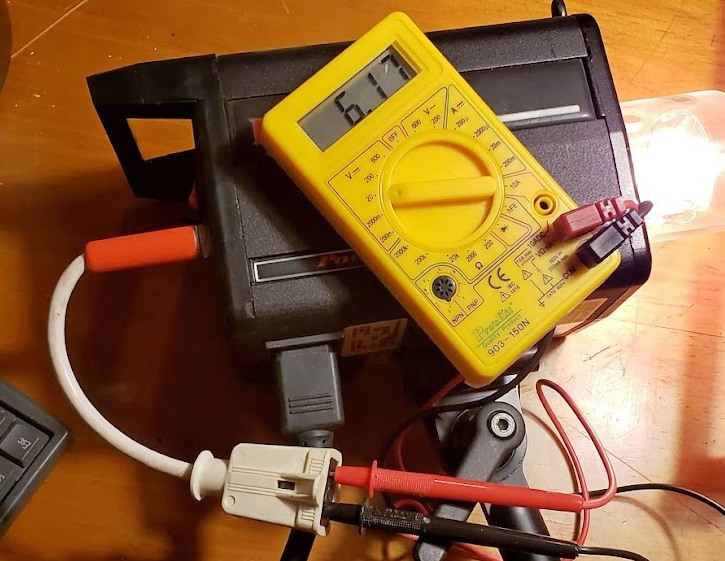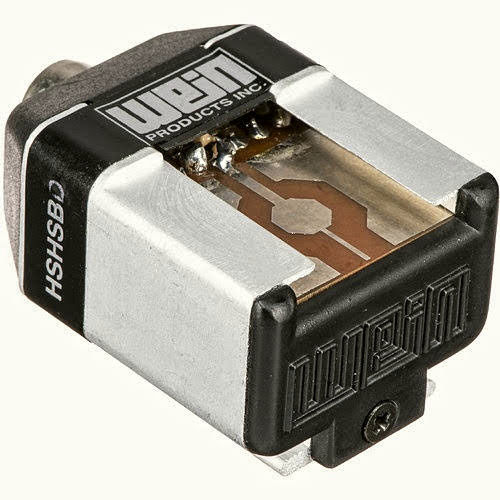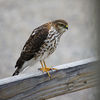Connecting an old strobe to a softbox
Feb 18, 2022 18:27:33 #
Hi All - I have an old Paul C. Buff White Lightning 10,000 (looks like a white coffee can) that works well as a slave triggered by another flash. I'd like to use the White Lightning as a master flash. I recently took a studio lighting course that shows the great effects a large softbox can create. Paul C. Buff says they no longer make an adapter to connect the strobe to a softbox, so I am wondering if anyone here has ideas/suggestions on how to connect and use the White Lightning with a softbox? If I connect it to a softbox, will the WL still be able to "see" another flash to be triggered (since it will be covered by the semi-opaque softbox)? I have heard that connecting the camera (Nikon D750) to the WL via a cable risks shorting out the camera, since the WL is plugged in to a wall outlet and creates quite a surge of power that may spill back to the camera via the cable. Anyone have ideas about an adapter or connector for the strobe to connect to a softbox, or thoughts about the risks of using a cable from the camera (and if so, what kind of cable to use? Thanks for any thoughts!
Feb 18, 2022 20:48:50 #
Those flash looks like they are made to use with an umbrella. You could build your own bracket to enable a softbox. I would be careful about the heat
Feb 18, 2022 20:53:12 #
Here's the specification as per trigger voltage:
Your camera can tolerate a maximum trigger voltage, that is the voltage coming through that synchronization cord directly connected to the camera) o is 250 DCV.
The listed trigger voltage for yo White Lightg Buff strobe is approx 24. VDC. If the strobe is in good work order it will not damage your camera. I always. however, recommend that the voltage be verified. If you have a multimeter, simply take a reading across the synch c socket or cord. You should be able to hard-wire the flas directly to your camera.
Softboxes:
There are many softboxes that do not require a special adaptation. you can place the strobe in the box withte a glass tube and reflector aimed at the back of the box. The scam at the from of the box will provide diffusion. If the reflector is removable, you can keep the unit in the middle of the inside of the box and light will bounce off the inner sides and back of the box and be further softened by the scrim.
I seem to recall that Buff made a very decent softbox for some of their units, It is sturdy and assembles quickly. Perhaps their ar someone in the used market. Otherwise, there are many other manufacturers such as Westcott, Photec, and Godox.
I assume if you place the strobe in the softbox, the built-in photoelectric cell that enables slave triggering will be hidden to the point where it will not "see" the light for your on-camer flash. If you don't want to hardwire it, you can purchase an inexpensive photoelectric cell (Wein is a popular brand) which will attach to a short synch cord and hag it outside of the box. Another alternate is a radio trigger. Buff makes a decent one, Pocket-Wizard is the kind of the industry standard, and Godox probably has one as well. A Transmitter mounts on the hot shoe and a receiver is attached to the strobe.
The only issue I can see with a totally enclose softbox and strobe setup is ventilation. If your Buff strobe has a 500-watt modelling lamp, the entry unt can overheat in a small box. A large box may be advisable. Some later mode units have built-in fans to help elevate excessive heat.
Yet another alternative for softer lighting is large white umbrellas, You can use them as large parabolic reflectors or shoot through them for a semi-softbox effect.
Your camera can tolerate a maximum trigger voltage, that is the voltage coming through that synchronization cord directly connected to the camera) o is 250 DCV.
The listed trigger voltage for yo White Lightg Buff strobe is approx 24. VDC. If the strobe is in good work order it will not damage your camera. I always. however, recommend that the voltage be verified. If you have a multimeter, simply take a reading across the synch c socket or cord. You should be able to hard-wire the flas directly to your camera.
Softboxes:
There are many softboxes that do not require a special adaptation. you can place the strobe in the box withte a glass tube and reflector aimed at the back of the box. The scam at the from of the box will provide diffusion. If the reflector is removable, you can keep the unit in the middle of the inside of the box and light will bounce off the inner sides and back of the box and be further softened by the scrim.
I seem to recall that Buff made a very decent softbox for some of their units, It is sturdy and assembles quickly. Perhaps their ar someone in the used market. Otherwise, there are many other manufacturers such as Westcott, Photec, and Godox.
I assume if you place the strobe in the softbox, the built-in photoelectric cell that enables slave triggering will be hidden to the point where it will not "see" the light for your on-camer flash. If you don't want to hardwire it, you can purchase an inexpensive photoelectric cell (Wein is a popular brand) which will attach to a short synch cord and hag it outside of the box. Another alternate is a radio trigger. Buff makes a decent one, Pocket-Wizard is the kind of the industry standard, and Godox probably has one as well. A Transmitter mounts on the hot shoe and a receiver is attached to the strobe.
The only issue I can see with a totally enclose softbox and strobe setup is ventilation. If your Buff strobe has a 500-watt modelling lamp, the entry unt can overheat in a small box. A large box may be advisable. Some later mode units have built-in fans to help elevate excessive heat.
Yet another alternative for softer lighting is large white umbrellas, You can use them as large parabolic reflectors or shoot through them for a semi-softbox effect.
Feb 19, 2022 06:46:08 #
kotography4u wrote:
Hi All - I have an old Paul C. Buff White Lightnin... (show quote)
I used to use a Wein Safesync on my digital camera for my Novatron strobes........maybe you can find a used adapter for your light and soft box. I no longer use the safesync, because I got the wireless kit.
Feb 19, 2022 08:49:40 #
I ran into the same problem with some Interfit strobes. I purchased some Interfit softboxes but they don't make the mounting ring for my particular model flash anymore. I found a solution at https://www.fjwestcott.com .
--Bob
--Bob
kotography4u wrote:
Hi All - I have an old Paul C. Buff White Lightnin... (show quote)
Feb 19, 2022 10:01:26 #
I own similar vintage White Lightnings and will happily recommend Mr. Shapiro's comments. My strobes have the light sensor on the rear and they will fire when seeing a flash. Most of the time I use a set of Pocket Wizards to control these strobes. Given the heat these babies generate, I would not recommend putting inside a softbox. I believe (but it's been too long) that mine have a Bowens mount. My current set are portable elinchroms. Best of luck.
Feb 19, 2022 11:26:22 #
azted
Loc: Las Vegas, NV.
I have purchased a set of octagonal softboxes for my two Paul C. Buff strobes. Adorama has a great price on their branded soft boxes. With the octagonal box, the unit sits outside the box and will sense the flash when working as a slave. On the other hand, the Pocket Wizards are phenomenal and work very well to fire all of your flashes. I also have the pocket wizard on my light meters so that the correct exposure can be set up in advance. I agree with the post above, that the rectangular soft boxes will not work well due to heat!
Feb 19, 2022 11:36:55 #
Feb 19, 2022 12:33:50 #
delder
Loc: Maryland
Tech Note:
Electronics Technician, not pro Photographer.
I would ALSO watch the CURRENT thru the camera contacts!
The idea of some Safesync type of protection sounds good.
Electronics Technician, not pro Photographer.
I would ALSO watch the CURRENT thru the camera contacts!
The idea of some Safesync type of protection sounds good.
Feb 19, 2022 12:44:58 #
You can get the same lighting effect using an umbrella I prefer to flash through a white umbrella as opposed to flashing off of it. Get a much more well rounded lighting. Upgrade to wireless flash figures such as pocketwizard you will never regret it
Feb 19, 2022 13:00:38 #
azted
Loc: Las Vegas, NV.
As an add on to my previous post, I went and looked at my purchase. You have to buy an adapter (Einstein to Bowens Mount Converter #GLCEIBW ) to mount your Buff strobe to the Glow Octo softboxes. But it locks in tight and you forget it is there! I can highly recommend this combination!
Feb 19, 2022 13:22:54 #
I do believe that most Paul Buff units used a standard speed ring, and Bowens as mentioned above sounds right.
The folks at Adorama or B&H will help. A good deal of the heat comes from the modeling light (unless you are shooting rapid fire) so once set up you can turn it down or off. Some softboxes have ventilation flaps that help.
Also you may be surprised at how powerful the flash is, so using it at half or quarter power also reduces heat.
Good luck
The folks at Adorama or B&H will help. A good deal of the heat comes from the modeling light (unless you are shooting rapid fire) so once set up you can turn it down or off. Some softboxes have ventilation flaps that help.
Also you may be surprised at how powerful the flash is, so using it at half or quarter power also reduces heat.
Good luck
Feb 19, 2022 14:38:04 #
delder wrote:
Tech Note:
Electronics Technician, not pro-Photographer.
I would ALSO watch the CURRENT thru the camera contacts!
The idea of some Safesync type of protection sounds good.
Electronics Technician, not pro-Photographer.
I would ALSO watch the CURRENT thru the camera contacts!
The idea of some Safesync type of protection sounds good.
This is true and very important. Every time this question arises, I too like to advise certain cautions to avoid any damage to equipment
According to the published specifications, the camera and strobe that OP indicated are compatible in terms of trigger voltage safety, There are, HOWEVER, caveats.
It's best to test the voltage to verify that in this case, the trigger voltage is below 250 VDC.
The Safe-Sync adapter is a good accessory to have on hand if anyone has older flas equiopmt that the wist to I use on currently made digital cameras. Most currently made flas gear has much lower trigger voltage than their predecessors. The Safe Sinc unit can be mounted in the hot shoe be between a Speedlight and the shoe and also has an outlet for a stand PC synchronization cord.
In one of the attached images, you can see how the voltage reading is made. The Buff unit in question probably has a 4/" audio or phone plug style of synch outlet. A simple adapter cord was made to enable the use of an H-type such cord. This also provides a convenient way to test for the trigger voltage. The unit has to be turned on and read to flas when the reading is mand. Also remember that the is not the operating voltage of the flaunt, which can be several hundred volts under high capacitance. This is the current coming through the trigger circuitry. The synchronization system in your camera acts as a light switch that completes the circuit and triggers the flash.
Voltages that exceed the camera's specification will not "blow up " the camer- it will not explode or electrocute the photograher. It will, however, cause damage to the camera's synchronization system and other electronics with the camera body. Also pictured is the Safe-Synch which reduces the current to a camera-safe level.
As for the adaptation of a generic softbox to you s the strobe. A mechanical metal adapter can be made to secure any softbox to most units. The caveat here is not only the mechanical attachment but the position of the flash tube/reflector of the unt within the box. Someof the lig shod be able to reflect off the sides and back of the box. Usually, with most helical flash tubes, more light is emitted from the sides of the tun than from the front. If the tube is too recessed in the adaptation so that insufficient light strikes the SIDES of the inside the box, you are losing light volume and ample diffusion. If the side of the tube is recessed and most of the light is coming from the front of the tube, you are losing the benefit of soft light reflecting from the inside sides of the box. In effect, you are just placing a diffuser (scrim) in form of a strobe. Just make certain that the flash tube is placed well in the box or use a softbox where the entire unit is enclosed in the box. There is a softbox where the strobe is placed through a zipper or Velcro-equipped slit of flap at the bottom of the modifier. If the reflector on the strobe can not be removed, aim the unit at the back of the box with some light striking the sides so you will get full benet of the softbox's efficiency and maximize the degree of diffusion.


Feb 20, 2022 10:59:41 #
E.L.. Shapiro wrote:
This is true and very important. Every time this ... (show quote)
Thanks so much for your detailed reply - I have never made "friends" with Mr. Electricity, so we keep each other at arms' length and your explanation and the pics will help me to venture into this area (with some trepidation, but I really don't want to short out my beloved D750 in the blink of an eye when it could have been avoided with precautions)
Feb 20, 2022 12:07:01 #
kotography4u wrote:
Thanks so much for your detailed reply - I have never made "friends" with Mr. Electricity, so we keep each other at arms' length and your explanation and the pics will help me to venture into this area (with some trepidation, but I really don't want to short out my beloved D750 in the blink of an eye when it could have been avoided with precautions)
I have been dabbling in electronics for many years and have, over many decades, serviced and modified my own electronic flash equipment. Nonetheless, I have still maintained a friendly-enemy relationship with "Mr. Electircity". An experienced lineman, who works with hydroelectric high tension installations, once told me that the young rookies on that job never sustain injuries or get electrocuted but the old-timers, who become a bit careless or flippant, are the ones who have serious or fatal accidents. Strobes do not involve hundreds of thousands of volts but an abundance of caution is wise when servicing this equipment.
Even smaller battery-powered flash unts can harbour dangerous voltages. That is because the battery voltage is stepped up and stored in capacitirs- basically, the same system on which cardiac defibrillators are based. The good news is that most modern flash gear is very safe, most are UL or CSA approved and unless you decide to poke around in the innards of this equipment with a screwdriver, or decide to use them in the bathtub or swimming pool, you are safe. The Buff folks have become known for good customer service so repairs should be referred to them.
If to are worried about directly wiring any falsh gear to your camera, a radio trigger is the most convenient and safe method. Buff makes a reasonably priced radio system. The transmitter is connected to the camera and receivers can be purchased for as many flash unts as you have in your system. Other units that are in use will still operate on their built-in photoelectric cell, so your radio system will just be required on the softbox if the photoelectric cell is hidden in the box.
If you want to reply, then register here. Registration is free and your account is created instantly, so you can post right away.




